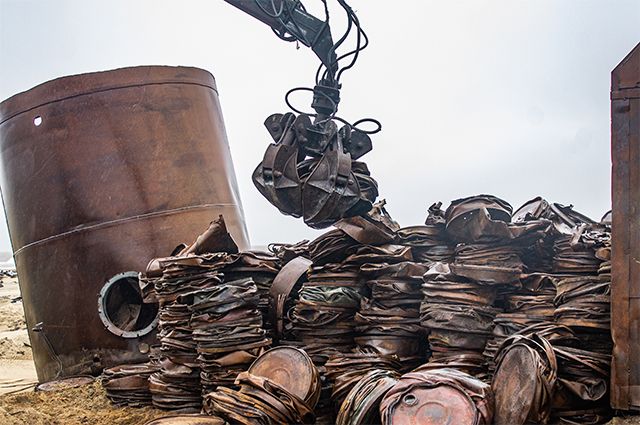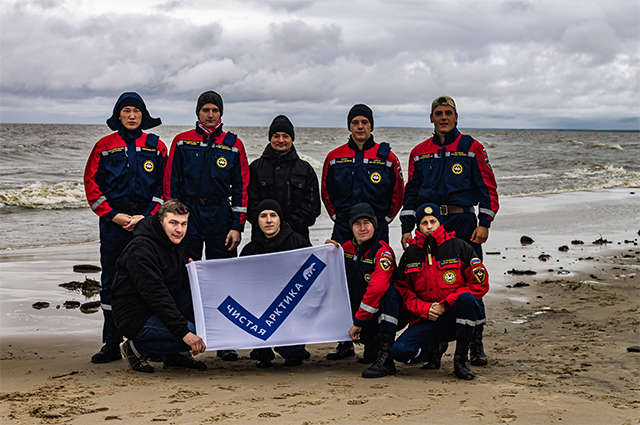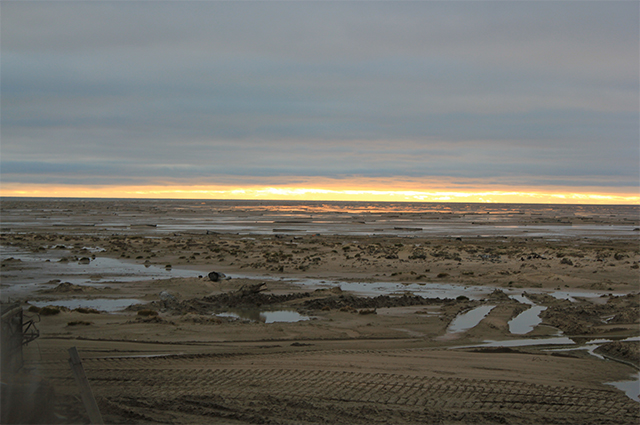
Vilkitsky Island will become the second after Bely Island, which will be cleared of the garbage accumulated over years of economic activity. And that should happen next year. What contribution have the volunteers of the Clean Arctic project made? & mdash; & nbsp; in the report “ Arguments and Facts. & # 39; & # 39;
Test of strength
Vilkitsky Island is located in the Kara Sea like a crescent. It is sandy and flat, & nbsp; there is water so shallow that ships cannot approach it. The highest point & mdash; & nbsp; is only 6 m above sea level.
Salekhard's helicopter & mdash; 5 hours with refueling. In the car, volunteers from the All-Russian Student Rescue Corps (VSKS), “ Clean Arctic '' expedition leader Alexey Rudkovsky, as well as the Deputy Governor of the Autonomous Okrug Yamalo-Nenets Alexander Mazharov. He flies to make sure the guys have good living conditions.

Yes, it's summer, but it's the arctic. Therefore, immediately in a warm jacket! Photo: Clean Arctic
The volunteers showed the skills of a well coordinated job as soon as the order was given to charge. Organized instantly and quickly loaded personal effects into the helicopter. And on arrival everything was unloaded so quickly and smoothly. Some of the guys already knew each other & mdash; & nbsp; together, they participated in eliminating the consequences of the Yalta floods. Others saw their comrades in the organization for the first time, but everyone has the skills.
I wonder if there were many who wanted to do this expedition. They reply that there are 50 people, but they took away 8.
While we are invited here & mdash; & nbsp; there are already 10 employees of the Russian Center for Arctic Development on the island. They & nbsp; arrived here in July and brought heavy equipment with them. Their main task is & mdash; & nbsp; mechanized preparation of bulky scrap metal for subsequent disposal from the island. To put it simply, they cut large fuel cans in half, squeeze small barrels and other junk, and load it all into large half barrels. They will then be loaded onto a ship to be exported from the island.

Russian Arctic Development Center Expedition Leader Sergei Dyachenko and Yamalo-Nenets Autonomous Okrug Deputy Governor Alexei Mazharov (left to right). Photo: Clean Arctic
Deputy Director of the Sergey Dyatchenko Center , who leads the professional expedition, met us at the helicopter side. And from that point on, the arctic got hot for us, although that can't be said about the weather.
As the guys bravely threw the bags away, he persuaded the helicopter crew to drown the car and have lunch with everyone. And so we sat together in the wardroom, and Vladimir, the cook of the expedition, feasts everyone on homemade borscht, fresh bread, tea.
Seeing the young rescuers bending over the food, the elders smile: more to come when the work begins! & # 39; & # 39;
Alexandre Mazharov, who has already examined the cabins, the dryer, the kitchen, the shower room and the toilets, at lunch he gives instructions to the volunteers in his own way and remembers his youth in the construction brigades.
These guys are not just another generation & mdash; & nbsp; they are already born into completely different realities. But they still have the same enthusiasm as the Soviet-era construction brigades, and the same motivations.
“ Along with the experience and the desire to help not in words, but in deeds, to show your skills, this is also a test of strength. Yet more than two weeks in a narrow circle, in difficult natural conditions, without communication and with a large amount of physical labor & mdash; & nbsp; this ordeal & raquo ;, & mdash; & nbsp; explains his decision to go to Vilkitsky Island Yaroslav Blazheev of Crimea .
Volunteers came from all over the country: in addition to Crimea, from Moscow, Orel, Buryatia, Mari-El.

The natural environment of Vilkitsky Island is in good condition, despite the large amount of rusty scrap metal. Photo by the author
Who's in the kitchen?
The only landmark on the island is the & mdash; & nbsp; lighthouse, the only building currently in operation & mdash; & nbsp; Soviet Arctic module 'Horizon'. The harsh Arctic weather and conditions have of course influenced the external condition of the structure, but it performs its functions perfectly: & nbsp; the module is dry, warm and comfortable. & Nbsp;
Once upon a time there was a military base and a weather station. After the military and meteorologists left, decaying buildings and a large number of fuel barrels, cans, as well as unused fuel and oil containers were left. The clean-up started in 2017, & nbsp; then & mdash; the efforts of Yamal enthusiasts with the support of regional authorities and the participation of volunteers from different regions.
Now the public project 'Clean Arctic' appeared. Teams of volunteers work in different arctic regions of the country. The guys who arrived here don't feel like guests on the island anymore. They are as caring and tidy as their seasoned professional colleagues.

The work is in full swing. Author photo
Upon arrival the question arose of feeding the team which had grown to 24 people. There is no problem with the food & mdash; & nbsp; the main part was delivered on an icebreaker with the equipment. And with every helicopter arrival there is a new supply of fresh vegetables and fruit. Chef Vladimir, whose working day begins at 6 in the morning, & mdash; passionate. For example, an arctic day for islanders might start with & hellip; Crepes. Yes, tender and warm pancakes in the middle of the Arctic Ocean, and even with honey! But he needed an assistant.
Young lifeguards weren't ready to trade the romance of hard work in the arctic wind for the comfort of warm cooking. However, the problem was resolved quickly. Stone, scissors, paper & mdash; & nbsp; and the kitchen service schedule have been established for the entire expedition.

Scrap metal prepared for shipment. Photo: Clean Arctic
Last point
A walk around the island is a bit like a walk by the sea & mdash; & nbsp; strong wind and rain, foam and water under your feet & hellip; All the time, orientation is lost, & nbsp; thank you, the lighthouse indicates the direction of movement. In local weather conditions, volunteers spend most of their free time in the module. But they're in a hurry to get down to business in the crisp arctic air.
“ Such projects are simply necessary. Without them, Vilkitsky Island and other arctic territories would remain inundated with garbage forever, & mdash; & nbsp; explains the general mood of the guys Yaroslav Blazheev.
“ I am a future OBZh teacher, and having experience in the arctic zone, feeling the local climate in my opinion is important. This will help teach children & raquo;, & mdash; & nbsp; added by his expedition companion Alexander Pelintsov from Moscow .

The only landmark on the island & ndash; Lighthouse. Author photo
Before our arrival, the work here, I must say, was enormous: & nbsp; almost all of the scrap was towed to shore, most of the taller structures were cut up, compressed, made ready for shipment. But there is still something left & mdash; & nbsp; a few places which cannot be reached by heavy equipment, you can only clean by hand. This is what VSCS volunteers do.
Pavel Orekhov, an employee of the Arctic Research Station of the Ural Branch of the Russian Academy of Sciences and the Earth Cryosphere Institute of the Tyumen Science Center of the Russian Academy of Sciences , who is also with us on the island, explains why the manual labor of the volunteers is necessary: “ It causes minimal damage to the surface. And any heavy equipment sinking violates the surface conditions of the ground, and permafrost can react to that. ''
“ They are awesome! & mdash; & nbsp; Sergey Dyatchenko praises the volunteers. & mdash; & nbsp; We couldn't have done so much without them.

Clean the arctic from man-made debris and ndash; this is very important, think the volunteers of the Clean Arctic project. Photo: Clean Arctic
During the time of the expedition, the Clean Arctic volunteers in collaboration with & nbsp; representatives of the Russian Arctic Development Center have already collected, compressed and & nbsp; prepared for & nbsp; over 3,000 200 liter barrels of fuel. In addition, each barrel first had to be dug into the & nbsp; silt, remove the washed sand and & nbsp; only then & mdash; & nbsp; in the press. In addition, the volunteers dismantled 5 destroyed buildings of the old military unit on 4 hectares, having collected more than 150 cubic meters. m of wood.
The volunteers returned to the mainland, and Dyachenko's detachment is still on the island & mdash; & nbsp; completes the preparation of scrap iron for shipment. In 1922, with the start of navigation, everything that is collected will be withdrawn. And then it will be possible to say that another arctic island has acquired its original form.
According to Pavel Orekhov, nature is recovering quickly. In Beloye, where the cleanup was completed last year, the surface coverage recovery rate exceeded expectations. And on Vilkitsky Island, according to him, the natural environment is now in good condition, despite the presence of a large amount of scrap metal.
“ The main danger lies in the containers with diesel fuel, fuels and lubricants, transformer fluids, & nbsp; this is what to remove. The Arctic is at high latitude here, and the activity of the microbiota that could process it is minimal, and it also has a short period of activity, ”he explains.

The only building currently in operation & ndash; Soviet Arctic Horizon module. Author photo
Alexey Rudkovsky has known the island since 2017, when the cleanup started here. He was one of the first enthusiasts. Now as the leader of the 'Clean Arctic' Project Volunteer Expedition He explains: “ The volunteers cannot participate in the loading of the ship. This process is either very fast (in good weather) and requires professional skills, or very long (in bad weather), when the vessel cannot disembark. Therefore, the guys on the current expedition have come to the end. ''
Meanwhile, the enormous work of cleaning up the Arctic continues. In the NAO, for example, Governor Yury Bezdudny took it under personal control. Here, as in other areas, hundreds of local residents are helping to clean up the Arctic. In addition, large-scale events are being prepared in the regions of Komi, Karelia, Murmansk and Arkhangelsk.
They are joined by Project Ambassador, popular host and eco-blogger Irena Ponaroshku. Thanks to joint efforts this summer, the scrap metal alone has already collected 600 tonnes. p>
Once the work is completed, you can admire the arctic sunsets. Photo by the author
Help The idea for the complete Arctic clean-up project belongs to the captain of the icebreaker “50 Let Pobedy” Dmitry Lobusov and the captain of the icebreaker, Hero of Labor of Russia Gennady Antokhin. The start of the project took place in the Public Chamber of the Russian Federation. At the same place, the All-Russian public organization “Green Patrol” launched the initiative to establish a special fund, co-chaired by the head of the Russian Ministry of Natural Resources, Alexander Kozlov. The project was supported by Rosprirodnadzor, ONF Molodezhka, VSKS, Clean Country Association of Waste Management Industry Operators, Norilsk Nickel MMC, Russian Railways, Orion and others.


